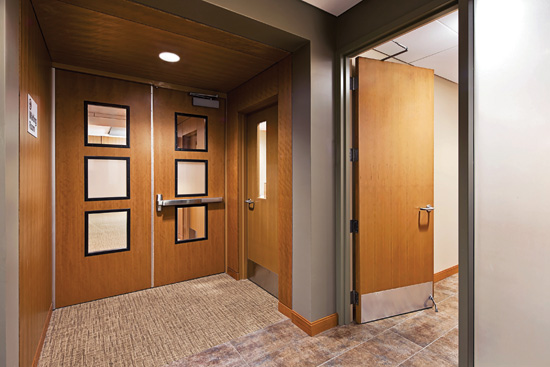Doorway to Distinctive Design
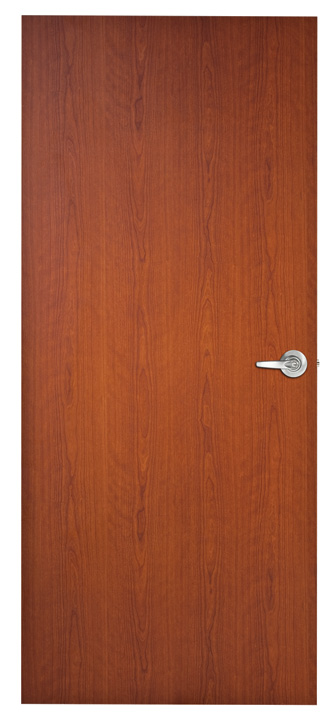
By its very nature, veneer is a sustainable practice, and the resource can be extended to many projects for maximum visual appeal.
Veneer Slicing
As mentioned previously, veneer is cut from the best trees with the fewest defects. The process involves several steps. Essentially, the cutting method for each log is determined first. The logs are then soaked and drained, and afterwards they are ready to be cut. After cutting, the slices of veneer are dried and bundled. The way in which the log is cut dictates the grain and appearance of the veneer. More specifically, the cutting method involves slicing through a tree's growth rings, and the angle at which the wood is cut produces a distinctive grain. Plain sliced or flat cut, quarter sliced, rift cut, and rotary are common veneer cutting methods.
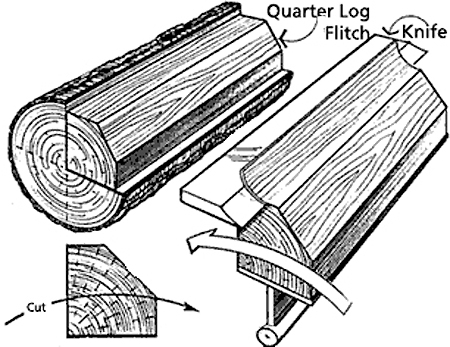
Plain sliced or flat cut veneer. The half log, or flitch, is mounted with the heart side against the guide plate of the slicer. Cuts are made parallel to a line through the center of the log, producing a distinct figure. The leaf width depends on log size and its placement in the flitch. By keeping the veneer leaves in the same order in which they are cut, the leaves can be reassembled with only a very gradual grain figure transition from one panel to another. Half round, a somewhat similar pattern, is achieved by turning a half log flitch on a lathe.
Quarter cut. A quarter log, or flitch, is mounted so that the slicer cuts the log at a 45° angle to the axis lines of the log, creating a striped or straight grain effect. A flake effect is produced in oak veneers using this method.
Rift cut. This method is generally restricted to red and white oak. A quarter log is mounted off center and cut slightly across the medullary rays common to oak, resulting in a straight grain without the flake effect of quarter sliced oak. To minimize this ray, or flake, effect, the angle of the cut is 15 degrees to the radial. The characteristic very tight and straight grain produced by the rift cut is known as the comb grain.
Rotary cut. This is a method of cutting in which the log is placed on a large lathe and turned against a fixed blade, so that a continuous cut is made round and round the log, more or less parallel at all times to the growth ring. The result is a wild, varied grain effect. Since the grain pattern is non-repetitive, it cannot be used for sequence matching. Component widths can vary from 4 inches to 12 inches. This type of cut may cause difficulty in staining some species, particularly red and white oak.
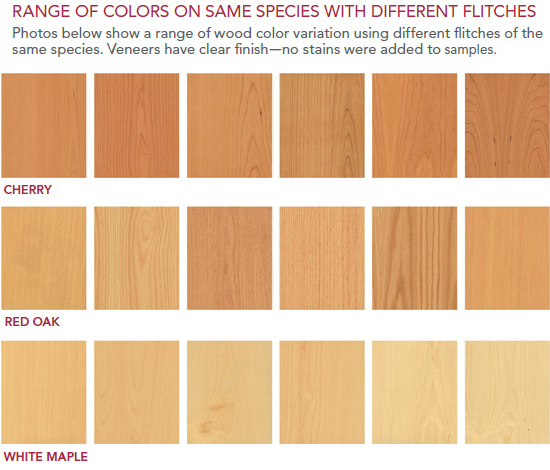
As a product of nature, wood will vary in color and grain from tree to tree, or even within the same tree.
Veneer Assembly Methods
Once the decorative veneer cutting method is specified, the type of match at the joint line must be determined. The way in which the individual cuts are matched or placed next to each other affects the appearance of the doors. Leaf matching and assembly matching are the most common types.
Leaf matching involves matching pairs of veneer cuts. Common types are book and slip matches. Book match is the most commonly used in the industry. Every other piece of veneer is turned over so adjacent pieces are opened like two adjacent pages in a book. The veneer joints match and create a mirrored image pattern at the joint line, yielding a maximum continuity of grain. Book matching is used with plain sliced, and less often with other cuts of veneer. Because the “tight” and “loose” faces alternate in adjacent pieces of veneer, they may accept stain or reflect light differently, resulting in a noticeable color variation, often called “barber pole.” These variations are not considered a manufacturing defect.
Slip matching refers to the adjoining of veneer components in sequence without turning over every other piece. The grain figure repeats, but joints will not show a mirrored effect. Slip matching is often used in quarter cut, rift cut, and comb grain veneers to minimize the barber pole effect. It may cause a leaning effect.
As the slicing advances, the leaves of veneer within a flitch will get wider or narrower, changing in appearance. To obtain a desired appearance in a door, how the individual leaves are configured requires specification. This is called an assembly match, and the most common arrangements are a running match, a balance match, and a center match. The running match is non-symmetrical in appearance on any single door face. Veneer pieces of unequal width are typical in this matching style, and each face is assembled from as many veneer pieces as necessary. It is the most common type of match. A balance match produces a more symmetrical appearance. Each face is assembled from an even or odd number of pieces of uniform width before trimming. This match reduces veneer yield. Center and balance matches also produce an asymmetrical appearance. Each face is assembled from an even number of veneer pieces of uniform width before trimming, and there is a veneer joint in the center of the panel. This match further reduces veneer yield.
Other assembly options include a pair match and a set match, which are specified for double doors. A pair match describes the way in which leaves of veneer are assembled for a pair of doors or a series of door pairs in the immediate vicinity. Doors may be, and in some grades must be, specified as pair matched where appropriate. A set match describes the way in which the leaves of veneer are assembled for sets of doors hung adjacently. Here again, doors hung in adjacent openings may be, and in some grades must be, specified as set matched.
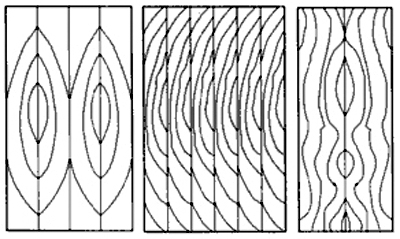
Reprinted with permission of AWI
Variations on the center and balance match include a book match (l), a slip match (c), and another take on a book match (r).
Standards
Architects should become familiar with standards set forth by the architectural flush wood door industry and assure that their veneer selection is consistent with or exceeds the established requirements. The primary quality standards are the Window and Door Manufacturers Association (WDMA I.S. 1-A) and the Architectural Woodwork Standards (AWS) Quality Standards, sections 5 and 9. WDMA is the industry standard for door manufacturers. The Architectural Woodwork Standards (AWS) are typically used in installations where the doors are blueprint matched with wall paneling and/or the doors are adjacent to millwork, requiring that the doors be consistent with the surrounding millwork. Most architectural and commercial doors are not directly associated with panels and/or millwork, and thus the WDMA requirements are more than adequate to assure consistent appearance among doors.





